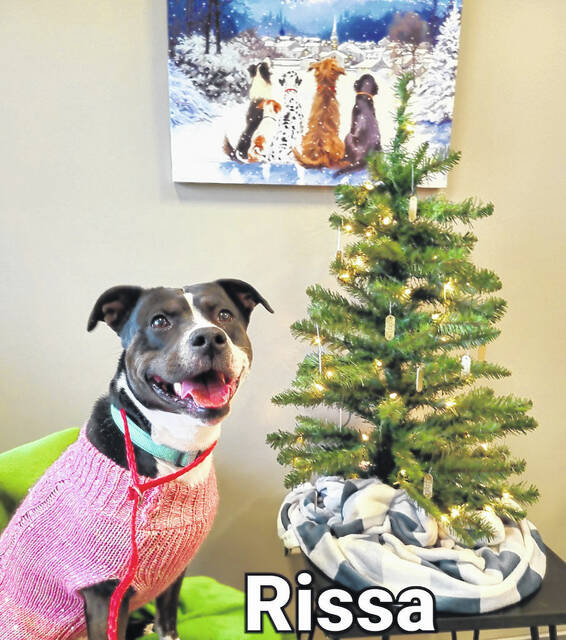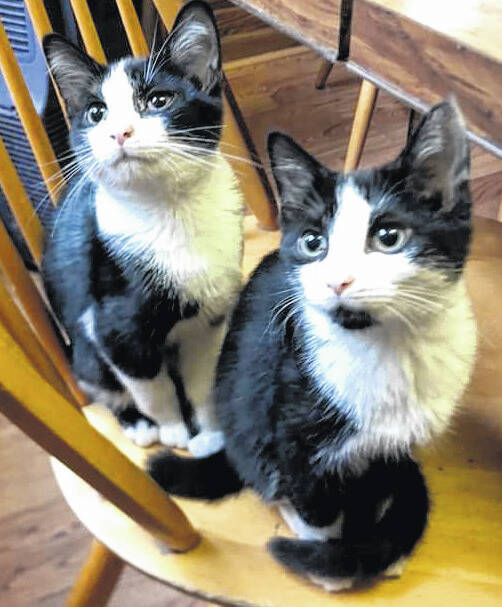


SIDNEY — Despite the fact that animals have their own fur coat to keep them warm, they are not immune to the cold weather.
If left to fend for themselves without human help, domesticated animals can develop physical problems or even die under harsh winter conditions.
Dogs
Wolves, which share a common ancestor with all modern dogs, have very different coats from many domesticated breeds. Wolves evolved to live in the wilderness, where they tracked their prey in the winter sometimes over 100 miles through snow drifts. Wolves can survive in temperatures as cold as -40 degrees Fahrenheit due to having two coat layers: a soft insulating undercoat that is shed in the spring, and a topcoat, which is made up of coarse guard hairs up to four inches long.
Other insulating factors also come into play.
Adult gray wolves maintain their highest body fat, roughly 19% of their mass, during the winter to provide additional insulation, and they can weigh up to 175 pounds.
Wolves’ feet are webbed and disproportionately large — up to 4 inches wide and 4 1/2 inches long. Their front feet each have five arched toes (including a dewclaw that does not touch the ground), while their back feet have just four arched toes each because they lack dewclaws. These characteristics allow them to walk over snow more easily, in fact, they distribute all their weight onto their toes, and are considered digit grades (animals that walk on their toes rather than their feet). The tips of their toes are blunt and have stiff hair that grips ice. Their paw pads are cushioned with fatty tissue and are covered by thick, calloused skin with papillae (bumps that grip like a car tire), and they contain specially evolved blood vessels that prevent freezing. Between each of its toes are scent glands to trace its path backwards and help prevent getting lost.
Arctic wolves also have biological adaptations like shorter ears and noses to help mitigate the biting arctic winds, allowing them to avoid frostbite even when temperatures reach -70 degrees Fahrenheit.
Man’s best friend, the dog, is among the oldest human animal companions. Archaeologists have found dog remains in Germany buried with their owners, dating from the Paleolithic era (14,000 years ago). Most domestic dog breeds, however, developed within the last 200 years. Sporting breeds were bred to have extra-long noses (especially those in the sight-hound group like Afghan Hounds, Greyhounds, Borzoi or Russian Wolfhounds, and Salukis) and large ears (especially those in the scent-hound group like Bloodhounds, Basset Hounds, and Coonhounds, and Beagles), thought to improve their ability to track scents, which work to their detriment in the cold.
According to the American Kennel Club, selective dog breeding is when certain canine traits become favorable over others and are encouraged by mating two animals with the same qualities together. Over the past few centuries, some dog breeds maintained their wild-like “double coat,” for example, the Husky, Malamute, Chow, Samoyed, German Shepherd breeds, but most domesticated dogs were bred to create less shedding, and have just a single coat of fur. Examples of breeds that are single coated, with very thin and delicate silky topcoats include the Yorkshire Terrier. The Chihuahua has a short, smooth single coat. Just like humans, these delicate animals with little to no hair shake and shiver in the cold to try to keep warm. In the winter, some of these tiny breeds can successfully get by using indoor or garage-based “pee pads,” and not need to go outdoors. Medium and large dogs, however, don’t have that option.
Wolves keep warm in part because of their size and mass. However, just because a domesticated dog is larger, does not mean it stays warmer. Many large dogs are “single coat” breeds. For example, weighing in at a whopping 230 pounds, the heaviest domesticated dog is a male English Mastiff. They, along with breeds like Rottweilers, Doberman Pinschers, Great Danes, Boxers, Weimeraners, and Dalmatians, can be highly susceptible to cold weather conditions.
Unlike their wild counterparts, domesticated dogs do not dig dens in the winter and therefore need shelter in winter months. Leaving a dog tethered outdoors in the open in the winter needs to be avoided. Freezing water dishes, wind gusts, and lack of warming body fat, are just a few reasons exposure to the elements can lead to hypothermia or death when dogs are left outdoors too long. Insulated dog houses, barns with straw, or attached garages with a heater (or electrically heated blanked or heated dog-bed) are preferred winter domiciles for canine “outdoor” pets.
More pet dogs become lost in the winter than any other time of the year. Taking additional measures, like adding physical or electronic fences, to keep a dog on your property during the winter, helps ensure their access to warm shelter. It also helps prevent curious pups from running amok, or possibly into the street where they could be injured or killed by a passing vehicle. When adding fence is not possible, or the cost falls outside a family’s budget, be sure to attend to dogs while outdoors, and leash them while on a walk. These three preventative measures are all great ways to prevent your pet from becoming lost or a stray. If, however, Fido is on the run, dog tags and micro-chipping are some of the best ways to ensure a safe and speedy return. Dog tag season runs from Dec. 1, 2021 through Jan. 31, 2022. The tags can be acquired at the Shelby County Animal Shelter for $18. If a stranger’s dog is spotted and on the loose, calling the animal shelter is one option for animal lovers. The Shelby County Animal Shelter is a “no kill” facility and can be reached by calling or emailing them by phone during their regular business hours. After hours reporting should be done by calling the Sidney Police Department.
The Shelby County Animal Shelter is not required by law to take in cats, so often stray and injured felines find temporary housing through nonprofit organizations.
Cats
The earliest archaeological evidence of domesticated cats is a burial site on the Mediterranean island of Cyprus estimated to be 9,500 years old. The cat remains were found a few centimeters from a human and pre-date the well-known Middle Kingdom ancient Egyptian mummified cats by nearly 4,000 years. The warm climates did little to weatherize feline genes. Cats became accepted as living among people during the Greco-Roman period, and as the Roman Empire spread to much colder Europe, so did cats. During the Age of Discovery, cats spread beyond the Mediterranean and Europe to many other parts of the world, including the U.S. Cats were useful to have aboard ships to control the rodent population, and were likely aboard the first ships to explore North America and are believed to have been aboard the Mayflower. Genetic sequencing showed that the African or Near East Wildcat (Felis sylvestris lybica) is the oldest ancestor to the domestic house cat, Felis catus.
According to International Cat Care, domestic cats and their lone-wandering wild cat ancestors (except lions) remain very much alike because their route to domestication was different — all other domesticated animals were domesticated through isolation from herds or packs — allowing cats the ability to revert to their feral state easily. That is, until the temperature dips below 45 degrees Fahrenheit.
Oddly, domestic cats share some physical traits with wolves. For example, they have five digits on their front feet and four on their back feet, and cushion-like pads on the bottoms of their feet. Cats have retractable claws, which allow them, like wolves, to walk on their toes, which means they are both digit grades. This makes remarkable sense if you consider both are predators and need to sneak up on their prey. Like wolves and “double-coated” dogs, many domestic cat breeds have an undercoat called “down hair” and a courser topcoat called “guard hair.” However, most cats’ bodies are covered by a third coat in the middle coat called “awn hair.” Haired cats have much softer and denser fur than dogs. Depending on the breed, the length can range from one and a half inches up to five inches — a full inch longer than wolves.
Cats will seek out existing human shelters, but if none are available, they can, like wolves, dig holes in the ground to serve as temporary dens. Unlike wolves, “outdoor” domestic and feral cats do not retain a lot of added body fat in the winter and therefore require more food each day to maintain their body temperature. Meanwhile indoor, domestic cats may innately desire more food in the winter, but overfeeding in warmer, indoor temperatures could lead to unnecessary weight gain.
Do not add a blanket in outdoor cat shelters in the winter, warned Rachel Minniear, director of the Shelby County Ohio Humane Society, because a blanket will freeze and draw away a cat’s body heat away, possibly leading hypothermia and death.
Fur-less pets
Non-mammals like reptiles, birds, and amphibians constitute a group of popular American fur-less pets. In nature, few reptiles and amphibians are naturally found in cold climates because they are cold-blooded. Many bird species fly south for the winter. Imported pets, like iguanas and parrots, never were equipped to manage freezing temperatures. Most of these pets are permanently indoors, but turning back a thermostat can be detrimental to these temperature-sensitive friends.
The winter-accessorized pet
According to Samantha Kovar, Assistant Manager at Chow Hound Pet Supplies in Sidney, a variety of pet accessories and pet-friendly products can help keep pets warm, happy, and healthy in winter:
• Dogs – Dogs paws are particularly vulnerable, so using paw-safe salt, dog boots, and paw pad moisturizer can help protect their sensitive feet, while dog coats and sweaters and a pet bed heating pad can keep up a dog’s internal body temperature.
• Cats – Outdoor cats need some type of small, dry shelter with natural straw insulation, or a heated kitty barn, as well as a heated water bowl, while indoor cats appreciate a heated kitty pad or mat.
• Others – Reptiles usually will need a tank thermometer, along with a heating light, basking and uv bulbs for daytime and — especially during winter nights when humans turn down their central heat — a non-light, tank-internal generating ceramic heat emitter or a tank-external heat mat.
Learn more about local animal welfare resources mentioned in the article:
Shelby County Animal Shelter, located at 610 Gerhart Road, can be reached by calling 937-498-7201, emailing [email protected], or visiting their website at https://co.shelby.oh.us/animal-shelter.
Shelby County Ohio Humane Society (SCOHS) can be reached by mailing P.O. Box 203, Sidney, Ohio, 45365, calling 937-658-4520, or visiting their Facebook page at https://www.facebook.com/shelbycountyohiohumanesociety.
Chow Hound Pet Supplies, located in the Vandemark Center at 2244 W. Michigan St. in Sidney, can be reached by calling 937-507-4541. The store is open Mondays through Sundays from 9 a.m. to 9 p.m., while the self-serve dog wash is open from 9 a.m. to 8 p.m. For more information, visit https://chowhoundpetsupplies.com.




